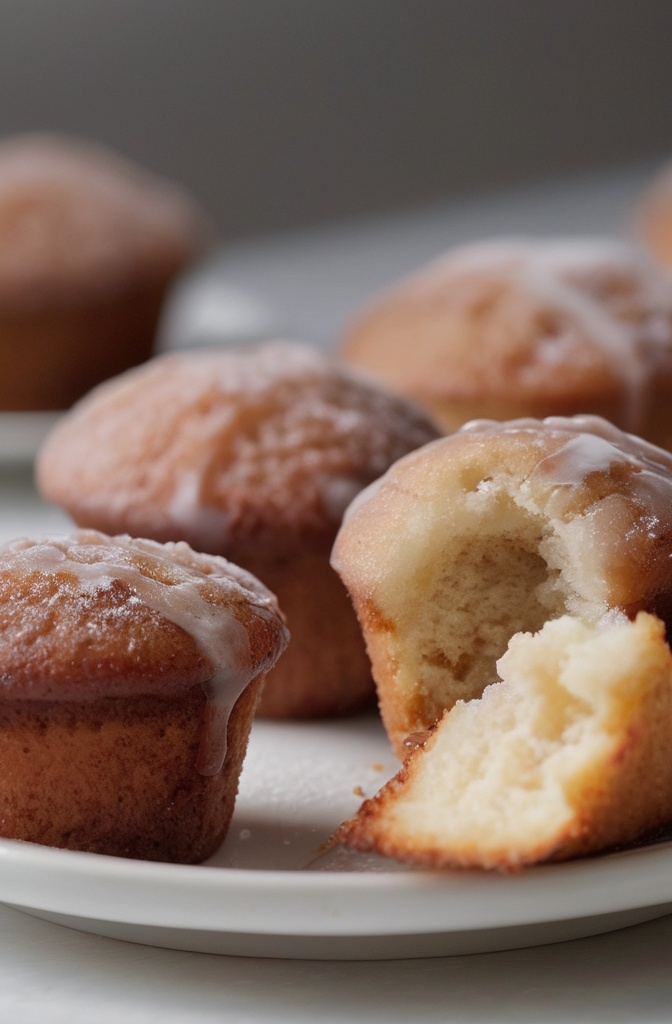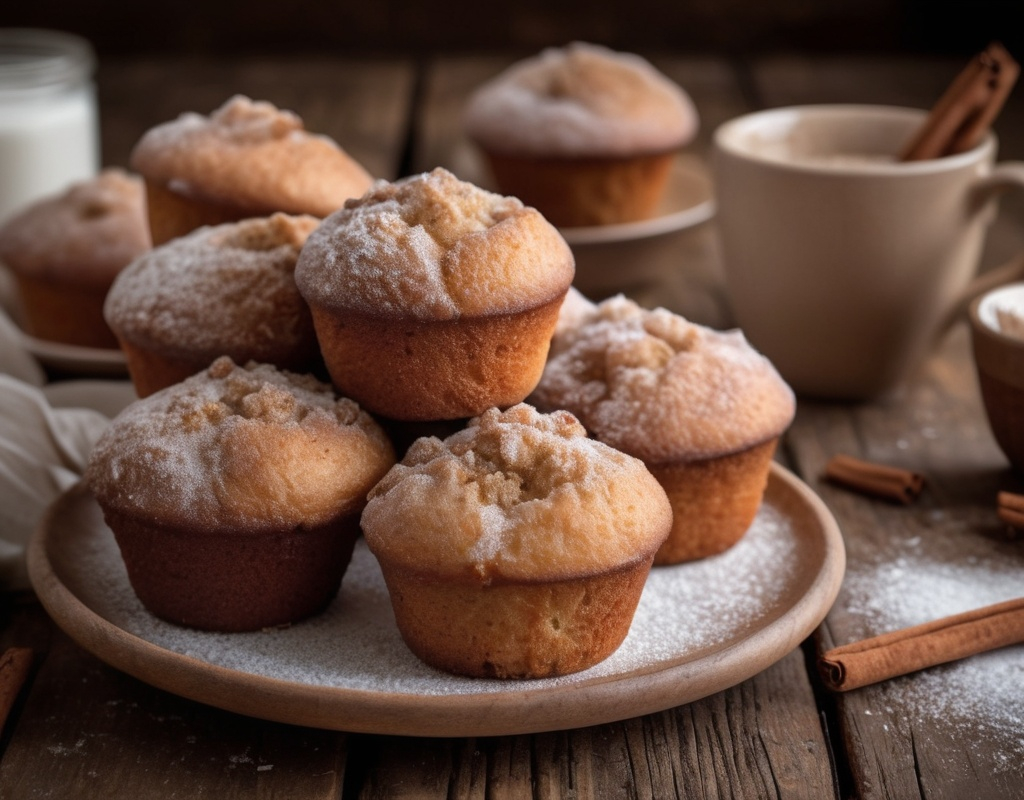Muffins that taste like doughnuts are a dream come true for anyone who loves the indulgent, fluffy texture of a muffin and the sweet, fried crispiness of a doughnut. Imagine sinking your teeth into a warm muffin, only to experience the sugary, spiced goodness of a doughnut. For professionals in the baking world, creating the perfect muffin that mimics a doughnut requires a deep understanding of flavor profiles, textures, and baking techniques. In this article, we’ll explore the science behind this tantalizing combination, share expert tips, and dive into practical methods to make these muffins your new favorite treat.
The Science Behind Muffins That Taste Like Doughnuts
So, what makes a muffin taste like a doughnut? It’s not magic—it’s science. Muffins and doughnuts might appear similar, but their textures and flavors differ significantly due to their ingredients and methods of preparation. While muffins are baked, doughnuts are typically fried, which gives them their signature crisp texture and rich flavor. To bridge this gap in a muffin, bakers need to create a balance between moisture, fat, and flavor.
The key to making muffins taste like doughnuts is in the fat content. Traditional doughnuts are deep-fried in oil, which adds a level of richness and crispiness. By adding ingredients like butter, sour cream, or buttermilk, you can replicate that rich, melt-in-your-mouth experience in a muffin. The texture of the muffin also plays a critical role. A doughnut has a dense yet tender crumb, which can be replicated by using cake flour or a combination of all-purpose and cake flour in your muffin batter.
In terms of flavor, doughnuts are often spiced with cinnamon and nutmeg, so incorporating these spices into your muffin batter is a must. To achieve the signature doughnut glaze, a light sugar coating or glaze on top of the muffin can recreate that iconic sweetness.
Perfecting the Doughnut Flavor
The flavor of a doughnut isn’t just about sugar—it’s about creating a symphony of tastes. When developing muffins that taste like doughnuts, you need to focus on a few key ingredients. Cinnamon, nutmeg, and vanilla are the heavy hitters in this department. But it’s not just about sprinkling a little bit of these spices into the batter. It’s about finding the right balance and experimenting with different ratios. Some bakers swear by a hint of cardamom to elevate the flavor, while others rely purely on the classic cinnamon-nutmeg combo.
To get that deep doughnut flavor, you should also consider the use of butter and oil in your batter. Butter adds flavor and richness, while oil creates that tender crumb that mimics a fried doughnut. The ratio of butter to oil will affect the flavor and texture, so don’t be afraid to experiment with different combinations. Another trick is adding a splash of vanilla extract. This ingredient helps enhance the sweetness without overpowering the delicate spiced notes.

Creating the Right Texture
Texture is just as important as flavor when it comes to making muffins that taste like doughnuts. If the muffin is too dry or too crumbly, it won’t provide the satisfying bite you expect from a doughnut. On the other hand, if the muffin is too moist or dense, it can feel like a soggy mess.
To achieve the ideal texture, many bakers recommend using cake flour or a blend of cake flour and all-purpose flour. Cake flour has a lower protein content, which creates a lighter, more tender texture. If you don’t have cake flour, you can easily make a substitute by removing 2 tablespoons of all-purpose flour from each cup and replacing it with cornstarch. The addition of buttermilk or sour cream also helps create a moist crumb that mimics the softness of a doughnut.
One important note here: mixing the batter too much can result in a dense muffin. When combining the wet and dry ingredients, stir just until everything is combined. Over-mixing can activate the gluten in the flour, making the muffins tough. Keep the mixing light and gentle for a soft, tender texture.
The Secret Ingredient: A Touch of Fried
To replicate that crispy exterior doughnut lovers crave, consider using a technique where you dip the tops of your muffins in melted butter and then roll them in a cinnamon-sugar mixture. This gives them the signature doughnut crust, but without frying them. The melted butter allows the sugar to adhere to the muffin, creating a crunchy, sweet coating that’s almost as satisfying as a doughnut’s fried glaze.
Another option is to create a glaze for your muffins. A simple glaze made with powdered sugar, milk, and vanilla extract will give your muffins that glossy, sugary finish reminiscent of a doughnut. Once glazed, the muffins will have that irresistible sheen and sweetness that makes doughnuts so delicious.
Flavor Variations and Combinations
While classic cinnamon and nutmeg are the go-to spices for doughnut-inspired muffins, there’s room for creativity. You could easily add chocolate chips or cocoa powder to make chocolate doughnut muffins. Or why not try a pumpkin spice version for a fall-inspired treat? The possibilities are endless, but it’s essential to keep the flavor balance in mind. Too much of one spice can overwhelm the taste, so use them in moderation.
If you’re feeling adventurous, experiment with different fillings. A jelly-filled doughnut-inspired muffin might include a dollop of fruit jam or preserves in the center. This could be anything from raspberry to blueberry or even lemon curd. To make these extra special, you could sprinkle some streusel on top for a crunchy contrast to the soft interior.
For a more decadent twist, you could infuse your muffins with a touch of espresso or even Irish cream liqueur. The combination of these rich flavors with the sweetness and spice of the muffin could elevate your creation to a whole new level. When working with these additions, however, be mindful of your liquid ratio to maintain the ideal texture.

Popular Recipes and Tips from the Pros
When developing your own muffin recipe that tastes like doughnuts, it’s helpful to look at a few tried-and-tested ideas from professional bakers. One popular variation comes from the famous New York-based bakery Magnolia Bakery, known for its doughnut-inspired muffins. Their recipe uses a combination of sour cream and buttermilk for the perfect balance of flavor and moisture. Magnolia’s version also includes a touch of honey, which deepens the sweetness without being overwhelming.
Bakers who’ve mastered this art often recommend a two-step method: first, bake the muffins until they’re golden and firm, then add the sugary topping right after they come out of the oven. This gives the sugar a chance to melt slightly, adhering to the warm muffin surface. The muffins are left to cool just a bit before being served, ensuring the cinnamon-sugar crust isn’t too sticky to handle.
Another pro tip is to experiment with different types of sugar. While classic white sugar is the most common for a glaze, some bakers use turbinado or demerara sugar for a crunchier texture. These sugars have larger crystals that won’t dissolve as quickly, creating an extra layer of texture and flavor on the muffin’s surface.
Common Misconceptions About Muffins That Taste Like Doughnuts
There are a few misconceptions that often trip up bakers when making muffins that taste like doughnuts. One common mistake is over-sweetening the batter. While doughnuts are sweet, muffins don’t need to be as sugary as a traditional doughnut. The sugar on the outside, combined with the spiced batter, provides enough sweetness.
Another misconception is that you need to fry the muffins to get that doughnut-like flavor and texture. Frying may give doughnuts a unique crispiness, but it’s unnecessary for these muffins. By using the right balance of fat, sugar, and flour, you can easily replicate that doughnut experience without ever touching hot oil.
Conclusion: Elevate Your Muffin Game
Muffins that taste like doughnuts are an exciting twist on two beloved baked goods. By understanding the science behind the flavors and textures, using the right ingredients, and experimenting with different spices and toppings, you can create a muffin that rivals the beloved doughnut. Whether you’re looking to impress customers at your bakery or just bake something special for friends and family, this recipe is one you’ll want to keep in your back pocket. So go ahead, take those muffins to the next level, and enjoy the sweet combination of doughnut flavor and muffin texture—your taste buds will thank you.
FAQs About Muffins That Taste Like Doughnuts
- What makes muffins taste like doughnuts? The rich, sweet flavor of doughnuts is replicated with butter, oil, cinnamon, nutmeg, and vanilla. A sugary topping or glaze adds the finishing touch.
- Can I use all-purpose flour instead of cake flour? Yes, but cake flour makes a softer, lighter texture. If using all-purpose, replace some with cornstarch to mimic cake flour.
- Do I need to fry the muffins to get that doughnut texture? No, you can achieve a doughnut-like texture through moist ingredients and a cinnamon-sugar or glaze topping.
- Can I add other flavors to my doughnut-inspired muffins? Yes, chocolate chips, pumpkin spice, and even espresso are great additions. Fillings like fruit preserves also work well.
- How can I make sure my muffins aren’t dry or crumbly? Avoid over-mixing the batter and use moist ingredients like sour cream or buttermilk for a tender crumb.
- What’s the best way to top the muffins for that doughnut experience? Brush with melted butter and roll in cinnamon-sugar or drizzle with a simple glaze for that signature doughnut finish.
- Can I make these muffins ahead of time? Yes, store them in an airtight container for a few days or freeze them for longer storage.
- What type of sugar should I use for the glaze or topping? Granulated sugar works, but turbinado or demerara sugars add a crunchy texture and richer flavor.
- Can I make these muffins gluten-free? Yes, use a gluten-free flour blend and consider extra moisture like sour cream to maintain the texture.
- What’s the secret to a perfectly tender, doughnut-like muffin? Use a mix of butter and oil, cake flour, and don’t over-mix the batter. Glaze or coat in cinnamon-sugar right after baking.

Mariana is a passionate home cook who creates delicious, easy-to-follow recipes for busy people. From energizing breakfasts to satisfying dinners and indulgent desserts, her dishes are designed to fuel both your body and hustle.
When she’s not in the kitchen, she’s exploring new flavors and dreaming up her next recipe to share with the Foodie Hustle community.

